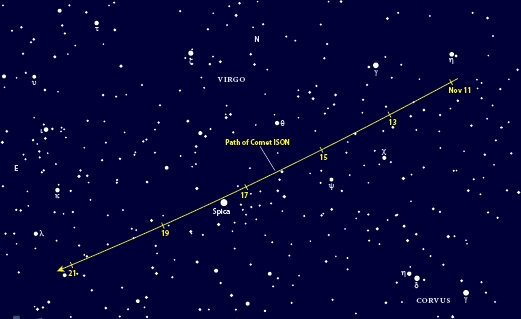“We have no idea … what ISON will do in the next couple of weeks! We simply urge everyone who can to get out and observe it while they can.”


… Emmanual Jehin from the University of Liege is reporting an outburst in Comet ISON, resulting in production rates that are double that of what they were a day earlier. The term “production rate” refers to the amount of different materials such as H2O, CO2, etc, that are being released from the comet’s surface …
It could be that the comet is now simply finally “turning on”. After all, it is now only 0.66AU (61,000,000mi, 99,000,000km) from the sun, and if it is to reach the [brightness] at perihelion we’ve always thought it would, then it needs to start brightening by an order or two magnitudes within the next week. So this could be really great news, and indicate that we are indeed going to have a nice bright comet in our solar spacecraft images in a couple of weeks time!
On the other hand, as always, there are caveats. Read on …


Scientists are asking if Comet ISON’s outburst indicates a trend leading to a nice visible comet in our night skies, or if the comet is merely flaring up and afterwards will get fainter again.
One possibility, they say, is that Comet ISON’s nucleus, or core, might have fragmented. Or a large fracture might have opened up in the surface of the nucleus, leading to an outpouring of volatile materials, thus increasing the comet’s brightness.
If that’s the case, then according to the Comet ISON Observing Campaign:
… the comet will likely brighten very rapidly over the next few days with a increasingly large dusty coma surrounding it and then begin to fade. Quite possibly it would simply fade out altogether in this situation, though some comets do outburst and then return to more normal levels.
… we have no idea what ISON is doing right now, or what it will do in the next couple of weeks! We simply urge everyone who can to get out and observe it while they can.The comet is headed into the morning twilight now, as it hurtles toward its November 28 perihelion, or closest point to the sun. Morning twilight is beginning to interfere with observations of Comet ISON, so if you’re going to search with binoculars … do it soon!
Michael Jager of Jauerling, Austria captured this image of the comet on November 10, 2013. It clearly shows that the comet, as it has approached the sun, has two tails: an ion tail (composed of ionized gas molecules) and a dust tail (created by bits of dirt that have come off the comet’s nucleus). Used with permission.
Bottom line: On November 13 and 14, 2013, observers are reporting an outburst in brightness from Comet ISON. The comet has been visible for binoculars for some days. It is now said to be at the threshold of visibility to the eye alone.
Republished / Source and read more at: EarthSky.org
TBU NEWS



